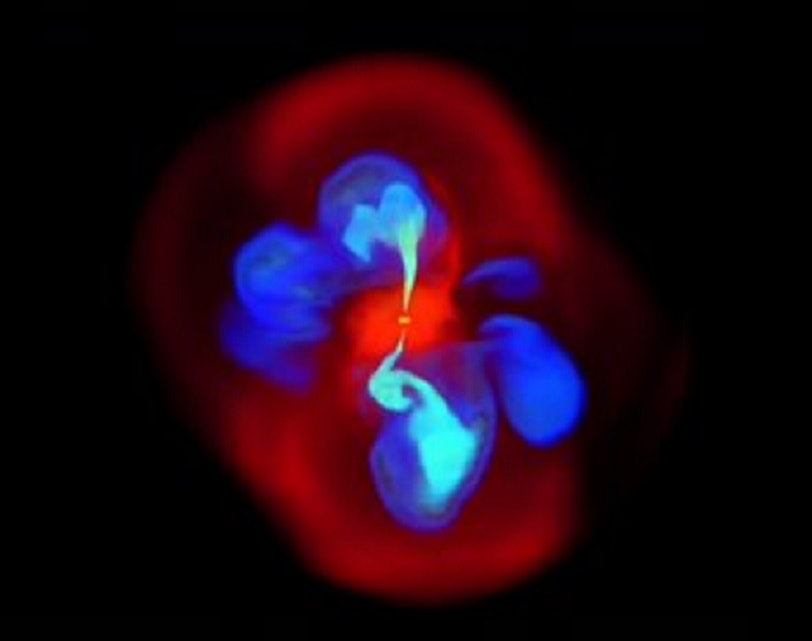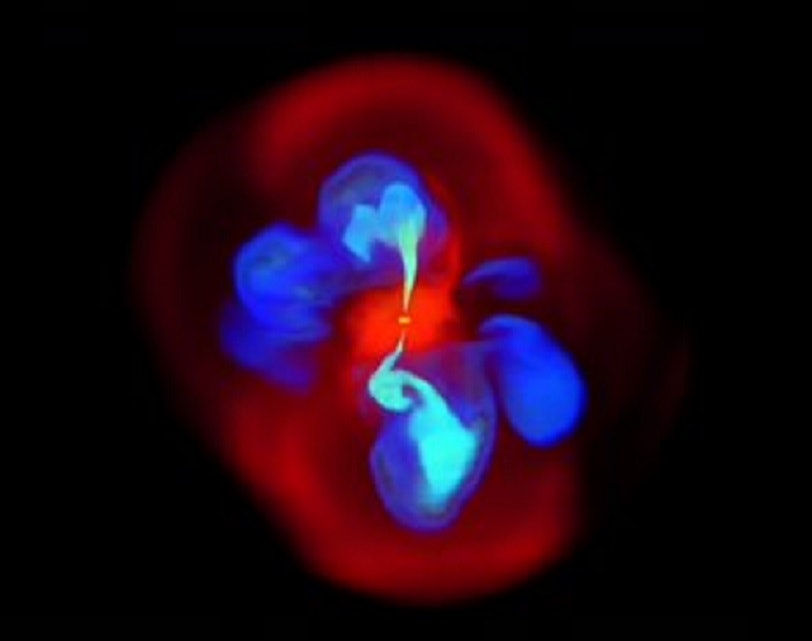
A computer simulation recently produced a rare type of galaxy completely by accident, and it’s pushing astronomers to rethink how these galaxies form and how rare they really are.
We usually think of galaxies as round, whether they’re intricate barred spirals or simpler ellipses, but a rare type of galaxy forms a bizarre X-shape by blasting two pairs of relativistic jets (streams of ionized particles, or plasma, moving at almost light speed) from the supermassive black hole at its center. Astronomers first discovered these galaxies about 20 years ago, and they’re still not sure how they form. They make up about 10 percent of radio galaxies — galaxies that emit more radio waves than visible light. But an accident during a simulation suggests the weird X-shape may be a phase that lots of radio galaxies go through.
What’s New — Aretaios Lalakos, a graduate student in astrophysics at Northwestern University, wasn’t thinking about the puzzle of X-shaped galaxies when he set up his computer simulation of a supermassive black hole. He just wanted to know how much mass the black hole would eat and how its accretion disk (the swirling disk of matter falling into the black hole) and relativistic jets would shape up over time. But something weird happened, and Lalakos’ simulated galaxy got messy.
As expected, the young black hole started blasting streams of plasma out into simulated space, where they collided with gas falling into the black hole. The plasma jets were moving at almost the speed of light, but they were thin, weak streams despite being so fast — so the gas was enough to scramble them. Lalakos watched the jets flicker and waver like a candle flame in a strong breeze.
In the process, the wobbling jets created a pair of cavities in the gas around the black hole, basically huge bubbles in the gas. Those bubbles “rose” away from the black hole in opposite directions. Meanwhile, on another axis, the jets fired up again and eventually grew strong enough to push through the gas, more like a blowtorch than a candle flame. The result was a pair of relativistic plasma jets moving on one axis and a pair of expanding bubbles in the gas moving on another axis. Together, they gave the galaxy a strange X shape when viewed in radio wavelengths.

“[Sasha Tcheckovskoy] said ‘Dude, this is very important! This is an X-shape!’ He told me that astronomers have observed this in real life and didn’t know how they formed,” Lalakos said in a press release. Tcheckovskoy, an astrophysicist at Northwestern University, is Lalakos’ advisor and a co-author on a recent paper in Astrophysical Journal Letters about the discovery.
Here’s the background – Astronomers have some ideas, of course. One is that X-shaped galaxies form when two smaller galaxies collide and their supermassive black holes merge (the kind of event that sends gravitational waves rippling through the universe). The even more supermassive black hole that results is spinning in a different direction, so its relativistic jets on one axis, and the expanding cosmic bubbles left behind by the old jet direction, form the crossbars of a galactic “X.”
“Another explanation is that the jet’s shape is altered as it interacts with large-scale gas enveloping an isolated supermassive black hole,” Lalakos said.
So far, however, no one had predicted that the X-shape happened as just part of a radio galaxy’s growth, especially not under extremely average circumstances. Lalakos and Tcheckovskoy suggest that their simulation surprise might mean that radio galaxies go through an X-shaped phase fairly often — or at least much more than 10 percent of the time. Because it’s just a phase that young radio galaxies grow out of, however, we don’t always get to see it. And that makes X-shaped galaxies look much rarer than they actually are, if Lalakos and Tcheckovskoy are correct.
“So they might be happening frequently, but we might not be lucky enough to see them because they only happen for as long as the power of the jet is too weak to push the gas away,” says Lalakos.
What’s next – The next step for Lalakos and Tcheckovskoy is finding out how often supermassive black holes distort their host galaxies into an X-shape. And that means running a lot more simulations, using different sizes of the accretion disk and different spin directions for the black hole at the center. So far, Lalakos has already tried a range of accretion disk masses and hasn’t gotten another X-shaped galaxy — so the strange phenomenon may still remain elusive.







